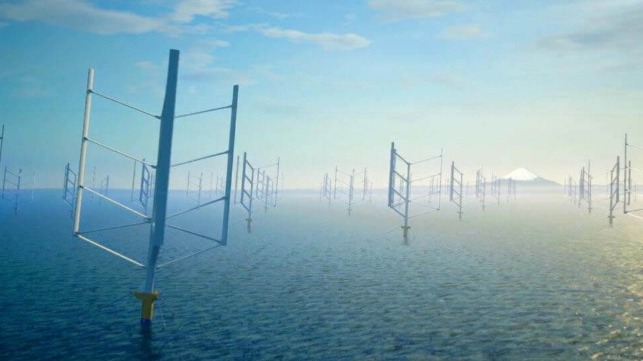Japanese to Study Feasibility of Floating Vertical Axis Wind Turbines

A consortium of companies in Japan is proceeding to the next phase of a project sponsored by the Japanese government to test the feasibility of large-scale floating vertical axis wind turbines. They believe that the new design can yield greater efficiency contributing to the commercial development of floating offshore wind turbines.
Commercializing floating wind technology is seen as critical to Japan’s ability to achieve its goals of transitioning to a significant portion of its power coming from renewable sources. The government is targeting renewable energy while seeking to encourage the transition from coal-fired and other high-emission power generation. Japan’s offshore topography however is challenging due to the volcanic nature of the island chain and the limited availability of relatively shallow coastal waters around Japan to support fixed-bottom wind turbines.
Japan’s national research and development agency, NEDO (New Energy and Industrial Technology Development Organization) has launched a public call for projects to develop next-generation technologies that help promote the adoption of floating offshore wind power. Five Japanese companies are leading the project including (“K” LINE (Kawasaki Kisen Kaisha) which is focusing on the installation, maintenance, and operation of the wind turbines. Albatross Technology is developing the design while J-Power and Tokyo Electric Power Company represent the energy industry.
Using a vertical axis wind turbine, the companies believe will increase the power generation and achieve a cost reduction for the overall installation and ongoing operation and maintenance expenses. The concept uses a series of smaller paddles, a maximum height of approximately 360 feet making it closer to the surface, and critically it can tilt up to 20 degrees while maintaining output. It uses a rotating cylindrical floating foundation. Conventional horizontal axis floating wind turbines have a high center of gravity which requires a large and expensive to build floating structure to maintain the stability of the turbines, especially in harsh conditions such as a typhoon.
The next phase of the project is a feasibility study to verify the viability of large-scale commercial vertical axis (floating axis) wind turbines, where both the turbine and floating foundation rotate together. The consortium will conduct design work to obtain basic design approval.
The partners previously said they plan to jointly develop a small-scale (20kW) experimental floating axis wind turbine that will be installed in Japanese waters. After confirming the validity of the analysis and design method, they plan to proceed to a larger scale (megawatt class) offshore demonstration project.
No comments:
Post a Comment